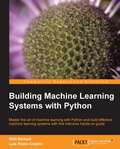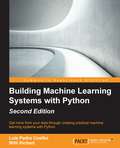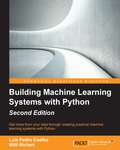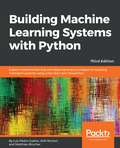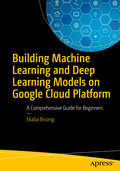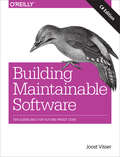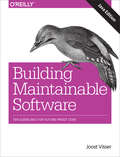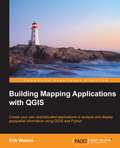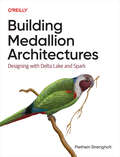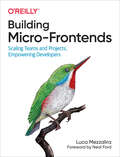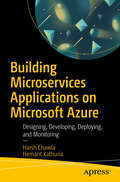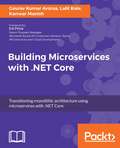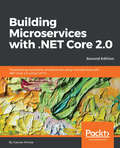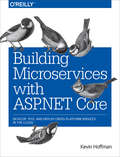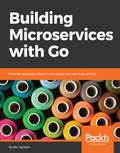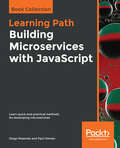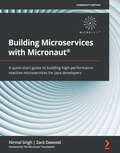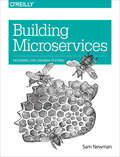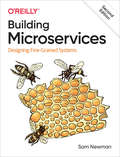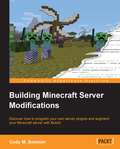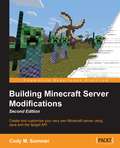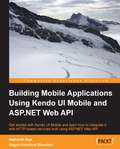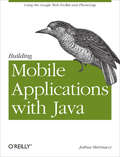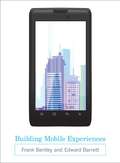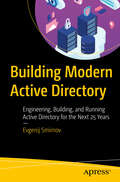- Table View
- List View
Building Machine Learning Systems with Python
by Luis Pedro Coelho Willi RichertA practical, scenario-based tutorial, this book will help you get to grips with machine learning with Python and start building your own machine learning projects. By the end of the book you will have learnt critical aspects of machine learning Python projects and experienced the power of ML-based systems by actually working on them. This book is for Python programmers who are beginners in machine learning, but want to learn Machine learning. Readers are expected to know Python and be able to install and use open-source libraries. They are not expected to know machine learning, although the book can also serve as an introduction to some Python libraries for readers who know machine learning. This book does not go into the detail of the mathematics behind the algorithms. This book primarily targets Python developers who want to learn and build machine learning in their projects, or who want to provide machine learning support to their existing projects, and see them getting implemented effectively.
Building Machine Learning Systems with Python - Second Edition
by Luis Pedro Coelho Willi RichertThis book primarily targets Python developers who want to learn and use Python's machine learning capabilities and gain valuable insights from data to develop effective solutions for business problems.
Building Machine Learning Systems with Python Second Edition
by Luis Pedro Coelho Willi Richert<P><P>Get more from your data through creating practical machine learning systems with Python <P><P>About This Book <P><P>Build your own Python-based machine learning systems tailored to solve any problem <P><P>Discover how Python offers a multiple context solution for create machine learning systems <P><P>Practical scenarios using the key Python machine learning libraries to successfully implement in your projects <P><P>Who This Book Is For <P><P>This book primarily targets Python developers who want to learn and use Python's machine learning capabilities and gain valuable insights from data to develop effective solutions for business problems. <P><P>What You Will Learn <P><P>Build a classification system that can be applied to text, images, or sounds <P><P>Use NumPy, SciPy, scikit-learn a “ scientific Python open source libraries for scientific computing and machine learning <P><P>Explore the mahotas library for image processing and computer vision <P><P>Build a topic model for the whole of Wikipedia <P><P>Employ Amazon Web Services to run analysis on the cloud <P><P>Debug machine learning problems <P><P>Get to grips with recommendations using basket analysis <P><P>Recommend products to users based on past purchases <P><P>In Detail <P><P>Using machine learning to gain deeper insights from data is a key skill required by modern application developers and analysts alike. Python is a wonderful language to develop machine learning applications. As a dynamic language, it allows for fast exploration and experimentation. With its excellent collection of open source machine learning libraries you can focus on the task at hand while being able to quickly try out many ideas. <P><P>This book shows you exactly how to find patterns in your raw data. You will start by brushing up on your Python machine learning knowledge and introducing libraries. You'll quickly get to grips with serious, real-world projects on datasets, using modeling, creating recommendation systems. Later on, the book covers advanced topics such as topic modeling, basket analysis, and cloud computing. These will extend your abilities and enable you to create large complex systems. <P><P>With this book, you gain the tools and understanding required to build your own systems, tailored to solve your real-world data analysis problems.
Building Machine Learning Systems with Python: Explore machine learning and deep learning techniques for building intelligent systems using scikit-learn and TensorFlow, 3rd Edition
by Luis Pedro Coelho Wilhelm Richert Matthieu BrucherGet more from your data by creating practical machine learning systems with PythonKey FeaturesDevelop your own Python-based machine learning systemDiscover how Python offers multiple algorithms for modern machine learning systemsExplore key Python machine learning libraries to implement in your projectsBook DescriptionMachine learning allows systems to learn things without being explicitly programmed to do so. Python is one of the most popular languages used to develop machine learning applications, which take advantage of its extensive library support. This third edition of Building Machine Learning Systems with Python addresses recent developments in the field by covering the most-used datasets and libraries to help you build practical machine learning systems.Using machine learning to gain deeper insights from data is a key skill required by modern application developers and analysts alike. Python, being a dynamic language, allows for fast exploration and experimentation. This book shows you exactly how to find patterns in your raw data. You will start by brushing up on your Python machine learning knowledge and being introduced to libraries. You'll quickly get to grips with serious, real-world projects on datasets, using modeling and creating recommendation systems. With Building Machine Learning Systems with Python, you’ll gain the tools and understanding required to build your own systems, all tailored to solve real-world data analysis problems.By the end of this book, you will be able to build machine learning systems using techniques and methodologies such as classification, sentiment analysis, computer vision, reinforcement learning, and neural networks.What you will learnBuild a classification system that can be applied to text, images, and soundEmploy Amazon Web Services (AWS) to run analysis on the cloudSolve problems related to regression using scikit-learn and TensorFlowRecommend products to users based on their past purchasesUnderstand different ways to apply deep neural networks on structured dataAddress recent developments in the field of computer vision and reinforcement learningWho this book is forBuilding Machine Learning Systems with Python is for data scientists, machine learning developers, and Python developers who want to learn how to build increasingly complex machine learning systems. You will use Python's machine learning capabilities to develop effective solutions. Prior knowledge of Python programming is expected.
Building Machine Learning and Deep Learning Models on Google Cloud Platform: A Comprehensive Guide for Beginners
by Ekaba BisongTake a systematic approach to understanding the fundamentals of machine learning and deep learning from the ground up and how they are applied in practice. You will use this comprehensive guide for building and deploying learning models to address complex use cases while leveraging the computational resources of Google Cloud Platform.Author Ekaba Bisong shows you how machine learning tools and techniques are used to predict or classify events based on a set of interactions between variables known as features or attributes in a particular dataset. He teaches you how deep learning extends the machine learning algorithm of neural networks to learn complex tasks that are difficult for computers to perform, such as recognizing faces and understanding languages. And you will know how to leverage cloud computing to accelerate data science and machine learning deployments.Building Machine Learning and Deep Learning Models on Google Cloud Platform is divided into eight parts that cover the fundamentals of machine learning and deep learning, the concept of data science and cloud services, programming for data science using the Python stack, Google Cloud Platform (GCP) infrastructure and products, advanced analytics on GCP, and deploying end-to-end machine learning solution pipelines on GCP.What You’ll Learn Understand the principles and fundamentals of machine learning and deep learning, the algorithms, how to use them, when to use them, and how to interpret your resultsKnow the programming concepts relevant to machine and deep learning design and development using the Python stackBuild and interpret machine and deep learning modelsUse Google Cloud Platform tools and services to develop and deploy large-scale machine learning and deep learning productsBe aware of the different facets and design choices to consider when modeling a learning problemProductionalize machine learning models into software products Who This Book Is For Beginners to the practice of data science and applied machine learning, data scientists at all levels, machine learning engineers, Google Cloud Platform data engineers/architects, and software developers
Building Maintainable Software, C# Edition: Ten Guidelines for Future-Proof Code
by Rob van der Leek Gijs Wijnholds Joost Visser Sylvan Rigal Pascal Van EckHave you ever felt frustrated working with someone else’s code? Difficult-to-maintain source code is a big problem in software development today, leading to costly delays and defects. Be part of the solution. With this practical book, you’ll learn 10 easy-to-follow guidelines for delivering C# software that’s easy to maintain and adapt. These guidelines have been derived from analyzing hundreds of real-world systems.Written by consultants from the Software Improvement Group (SIG), this book provides clear and concise explanations, with advice for turning the guidelines into practice. Examples for this edition are written in C#, while our companion Java book provides clear examples in that language.Write short units of code: limit the length of methods and constructorsWrite simple units of code: limit the number of branch points per methodWrite code once, rather than risk copying buggy codeKeep unit interfaces small by extracting parameters into objectsSeparate concerns to avoid building large classesCouple architecture components looselyBalance the number and size of top-level components in your codeKeep your codebase as small as possibleAutomate tests for your codebaseWrite clean code, avoiding "code smells" that indicate deeper problems
Building Maintainable Software, Java Edition: Ten Guidelines for Future-Proof Code
by Rob van der Leek Gijs Wijnholds Joost Visser Sylvan Rigal Pascal Van EckHave you ever felt frustrated working with someone else’s code? Difficult-to-maintain source code is a big problem in software development today, leading to costly delays and defects. Be part of the solution. With this practical book, you’ll learn 10 easy-to-follow guidelines for delivering Java software that’s easy to maintain and adapt. These guidelines have been derived from analyzing hundreds of real-world systems.Written by consultants from the Software Improvement Group (SIG), this book provides clear and concise explanations, with advice for turning the guidelines into practice. Examples for this edition are written in Java, while our companion C# book provides workable examples in that language.Write short units of code: limit the length of methods and constructorsWrite simple units of code: limit the number of branch points per methodWrite code once, rather than risk copying buggy codeKeep unit interfaces small by extracting parameters into objectsSeparate concerns to avoid building large classesCouple architecture components looselyBalance the number and size of top-level components in your codeKeep your codebase as small as possibleAutomate tests for your codebaseWrite clean code, avoiding "code smells" that indicate deeper problems
Building Mapping Applications with QGIS
by Erik WestraIf you are an experienced Python developer who wants to create your own geospatial applications with minimum fuss, this is the book for you. While some familiarity with mapping applications would be an advantage, no prior knowledge of geospatial concepts is required. Even if you've never used QGIS before, this book will quickly get you up to speed.
Building Medallion Architectures
by Piethein StrengholtIn today's data-driven world, organizations must manage and analyze vast amounts of information to deliver the insights that give them a competitive advantage. Many turn to the medallion architecture because it's a proven and well-known design. Yet implementing a robust data pipeline can be difficult, particularly when it comes to using the medallion architecture's bronze, silver, and gold layers—done wrong, it can hamper your ability to make data-driven decisions. This practical guide helps you build a medallion architecture the right way with Azure Databricks and Microsoft Fabric. Drawing on hands-on experience from the field, Piethein Strengholt demystifies common assumptions and complex problems you'll face when embarking on a new data architecture. Architects and engineers of all stripes will find answers to the most typical questions along with insights from real organizations about what's worked, what hasn't, and why. You'll learn:Lakehouse and medallion architecture fundamentals and key conceptsDesign considerations for Azure Databricks and Microsoft FabricScaling considerations, including governance, security, automation, and moreHow to make informed decisions when designing or implementing new data architecturesProven patterns for success that align with broader organizational objectives
Building Micro-Frontends: Scaling Teams and Projects, Empowering Developers
by Luca MezzaliraWhat's the answer to today's increasingly complex web applications? Micro-frontends. Inspired by the microservices model, this approach lets you break interfaces into separate features managed by different teams of developers. With this practical guide, Luca Mezzalira shows software architects, tech leads, and software developers how to build and deliver artifacts atomically rather than use a big bang deployment.You'll learn how micro-frontends enable your team to choose any library or framework. This gives your organization technical flexibility and allows you to hire and retain a broad spectrum of talent. Micro-frontends also support distributed or colocated teams more efficiently. Pick up this book and learn how to get started with this technological breakthrough right away.Explore available frontend development architecturesLearn how microservice principles apply to frontend developmentUnderstand the four pillars for creating a successful micro-frontend architectureExamine the benefits and pitfalls of existing micro-frontend architecturesLearn principles and best practices for creating successful automation strategiesDiscover patterns for integrating micro-frontend architectures using microservices or a monolith API layer
Building Microservices Applications on Microsoft Azure: Designing, Developing, Deploying, and Monitoring
by Harsh Chawla Hemant KathuriaImplement microservices starting with their architecture and moving on to their deployment, manageability, security, and monitoring. This book focuses on the key scenarios where microservices architecture is preferred over a monolithic architecture.Building Microservices Applications on Microsoft Azure begins with a survey of microservices architecture compared to monolithic architecture and covers microservices implementation in detail. You'll see the key scenarios where microservices architecture is preferred over a monolithic approach. From there, you will explore the critical components and various deployment options of microservices on platforms such as Microsoft Azure (public cloud) and Azure Stack (hybrid cloud). This includes in-depth coverage of developing, deploying, and monitoring microservices on containers and orchestrating with Azure Service Fabric and Azure Kubernetes Cluster (AKS).This book includes practical experience from large-scale enterprise deployments, therefore it can be a quick reference for solution architects and developers to understand the critical factors while designing a microservices application. What You Will LearnExplore the use cases of microservices and monolithic architectureDiscover the architecture patterns to build scalable, agile, and secure microservices applicationsDevelop and deploy microservices using Azure Service Fabric and Azure Kubernetes Service Secure microservices using the gateway patternSee the deployment options for Microservices on Azure StackImplement database patterns to handle the complexities introduced by microservices Who This Book Is ForArchitects and consultants who work on Microsoft Azure and manage large-scale deployments.
Building Microservices with .NET Core
by Gaurav Kumar Aroraa Kanwar Manish Lalit KaleArchitect your .NET applications by breaking them into really small pieces—microservices—using this practical, example-based guide About This Book • Start your microservices journey and understand a broader perspective of microservices development • Build, deploy, and test microservices using ASP.Net MVC, Web API, and Microsoft Azure Cloud • Get started with reactive microservices and understand the fundamentals behind it Who This Book Is For This book is for .NET Core developers who want to learn and understand microservices architecture and implement it in their .NET Core applications. It's ideal for developers who are completely new to microservices or have just a theoretical understanding of this architectural approach and want to gain a practical perspective in order to better manage application complexity. What You Will Learn • Compare microservices with monolithic applications and SOA • Identify the appropriate service boundaries by mapping them to the relevant bounded contexts • Define the service interface and implement the APIs using ASP.NET Web API • Integrate the services via synchronous and asynchronous mechanisms • Implement microservices security using Azure Active Directory, OpenID Connect, and OAuth 2.0 • Understand the operations and scaling of microservices in .NET Core • Understand the testing pyramid and implement consumer-driven contract using pact net core • Understand what the key features of reactive microservices are and implement them using reactive extension In Detail Microservices is an architectural style that promotes the development of complex applications as a suite of small services based on business capabilities. This book will help you identify the appropriate service boundaries within the business. We'll start by looking at what microservices are, and what the main characteristics are. Moving forward, you will be introduced to real-life application scenarios, and after assessing the current issues, we will begin the journey of transforming this application by splitting it into a suite of microservices. You will identify the service boundaries, split the application into multiple microservices, and define the service contracts. You will find out how to configure, deploy, and monitor microservices, and configure scaling to allow the application to quickly adapt to increased demand in the future. With an introduction to the reactive microservices, you strategically gain further value to keep your code base simple, focusing on what is more important rather than the messy asynchronous calls. Style and approach This guide serves as a stepping stone that helps .NET Core developers in their microservices architecture. This book provides just enough theory to understand the concepts and apply the examples.
Building Microservices with .NET Core 2.0: Transitioning monolithic architectures using microservices with .NET Core 2.0 using C# 7.0, 2nd Edition
by Gaurav AroraaKey Features Start your microservices journey and get a broader perspective on microservices development using C# 7.0 with .NET Core 2.0 Build, deploy, and test microservices using ASP.Net Core, ASP.NET Core API, and Microsoft Azure Cloud Get the basics of reactive microservices Book Description The microservices architectural style promotes the development of complex applications as a suite of small services based on business capabilities. This book will help you identify the appropriate service boundaries within your business. We'll start by looking at what microservices are and their main characteristics. Moving forward, you will be introduced to real-life application scenarios; after assessing the current issues, we will begin the journey of transforming this application by splitting it into a suite of microservices using C# 7.0 with .NET Core 2.0. You will identify service boundaries, split the application into multiple microservices, and define service contracts. You will find out how to configure, deploy, and monitor microservices, and configure scaling to allow the application to quickly adapt to increased demand in the future. With an introduction to reactive microservices, you’ll strategically gain further value to keep your code base simple, focusing on what is more important rather than on messy asynchronous calls. What you will learn Get acquainted with Microsoft Azure Service Fabric Compare microservices with monolithic applications and SOA Learn Docker and Azure API management Define a service interface and implement APIs using ASP.NET Core 2.0 Integrate services using a synchronous approach via RESTful APIs with ASP.NET Core 2.0 Implement microservices security using Azure Active Directory, OpenID Connect, and OAuth 2.0 Understand the operation and scaling of microservices in .NET Core 2.0 Understand the key features of reactive microservices and implement them using reactive extensions
Building Microservices with ASP.NET Core: Develop, Test, and Deploy Cross-Platform Services in the Cloud
by Kevin HoffmanAt a time when nearly every vertical, regardless of domain, seems to need software running in the cloud to make money, microservices provide the agility and drastically reduced time to market you require. This hands-on guide shows you how to create, test, compile, and deploy microservices, using the ASP.NET Core free and open-source framework. Along the way, you’ll pick up good, practical habits for building powerful and robust services.Building microservices isn’t about learning a specific framework or programming language; it’s about building applications that thrive in elastically scaling environments that don't have host affinity, and that can start and stop at a moment’s notice. This practical book guides you through the process.Learn test-driven and API-first development conceptsCommunicate with other services by creating and consuming backing services such as databases and queuesBuild a microservice that depends on an external data sourceLearn about event sourcing, the event-centric approach to persistenceUse ASP.NET Core to build web applications designed to thrive in the cloudBuild a service that consumes, or is consumed by, other servicesCreate services and applications that accept external configurationExplore ways to secure ASP.NET Core microservices and applications
Building Microservices with Go
by Nic JacksonYour one-stop guide to the common patterns and practices, showing you how to apply these using the Go programming language About This Book • This short, concise, and practical guide is packed with real-world examples of building microservices with Go • It is easy to read and will benefit smaller teams who want to extend the functionality of their existing systems • Using this practical approach will save your money in terms of maintaining a monolithic architecture and demonstrate capabilities in ease of use Who This Book Is For You should have a working knowledge of programming in Go, including writing and compiling basic applications. However, no knowledge of RESTful architecture, microservices, or web services is expected. If you are looking to apply techniques to your own projects, taking your first steps into microservice architecture, this book is for you. What You Will Learn • Plan a microservice architecture and design a microservice • Write a microservice with a RESTful API and a database • Understand the common idioms and common patterns in microservices architecture • Leverage tools and automation that helps microservices become horizontally scalable • Get a grounding in containerization with Docker and Docker-Compose, which will greatly accelerate your development lifecycle • Manage and secure Microservices at scale with monitoring, logging, service discovery, and automation • Test microservices and integrate API tests in Go In Detail Microservice architecture is sweeping the world as the de facto pattern to build web-based applications. Golang is a language particularly well suited to building them. Its strong community, encouragement of idiomatic style, and statically-linked binary artifacts make integrating it with other technologies and managing microservices at scale consistent and intuitive. This book will teach you the common patterns and practices, showing you how to apply these using the Go programming language. It will teach you the fundamental concepts of architectural design and RESTful communication, and show you patterns that provide manageable code that is supportable in development and at scale in production. We will provide you with examples on how to put these concepts and patterns into practice with Go. Whether you are planning a new application or working in an existing monolith, this book will explain and illustrate with practical examples how teams of all sizes can start solving problems with microservices. It will help you understand Docker and Docker-Compose and how it can be used to isolate microservice dependencies and build environments. We finish off by showing you various techniques to monitor, test, and secure your microservices. By the end, you will know the benefits of system resilience of a microservice and the advantages of Go stack. Style and approach The step-by-step tutorial focuses on building microservices. Each chapter expands upon the previous one, teaching you the main skills and techniques required to be a successful microservice practitioner.
Building Microservices with JavaScript: Learn quick and practical methods for developing microservices
by Diogo Resende Paul OsmanExplore microservices by developing with Express, deploying with Docker, and scaling with Swarm and Kubernetes.Key FeaturesBuild cloud-native microservices using only Node and ExpressWrite clean and maintainable code with JavaScript for improved microservices developmentLearn ways to monitor and manage your services in a production environmentBook DescriptionMicroservices are a popular way to build distributed systems that power modern web and mobile apps. With the help of this Learning Path, you'll learn how to develop your applications as a suite of independently deployable and scalable services.Using an example-driven approach, this Learning Path will uncover how you can dismantle your monolithic application and embrace microservice architecture, right from architecting your services and modeling them to integrating them into your application. You’ll also explore ways to overcome challenges in testing and deploying these services by setting up deployment pipelines that break down the application development process into several stages. You’ll study serverless architecture for microservices and understand its benefits. Furthermore, this Learning Path delves into the patterns used for organizing services, helping you optimize request handling and processing. You'll then move on to learn the fault-tolerance and reliability patterns that help you use microservices to isolate failures in your applications.By the end of this Learning Path, you’ll have the skills necessary to build enterprise-ready applications using microservices.This Learning Path includes content from the following Packt products:Hands-On Microservices with Node.js by Diogo ResendeMicroservices Development Cookbook by Paul OsmanWhat you will learnUse Docker and Swarm for continuous deployment and scalingBuild and deploy cloud-native microservices and avoid vendor lock-inExplore different service architectures such as Hydra and SenecaCreate services that don’t impact users upon failureMonitor your services to perform debugging and create observable systemsDevelop fast and reliable deployment pipelinesManage multiple environments for your servicesSimplify the local development of microservice-based systemsWho this book is forIf you’re a JavaScript developer looking to put your skills to work by building microservices and moving away from the monolithic architecture, this book is for you. To understand the concepts explained in this Learning Path, you must have knowledge of Node.js and be familiar with the microservices architecture.
Building Microservices with Micronaut®: A quick-start guide to building high-performance reactive microservices for Java developers
by Nirmal Singh Zack Dawood A23 The Micronaut® FoundationExplore different aspects of building modular microservices such as development, testing, maintenance, and deployment using the Micronaut frameworkKey FeaturesLearn how to build scalable, fast, and resilient microservices with this concise guideExplore the many advantages of using reflection-free, compile-time dependency injections and aspect-oriented programmingBuild cloud-native applications easily with the Micronaut frameworkBook DescriptionThe Micronaut® open source software is a JVM-based framework, designed to create microservices quickly and easily. This book will help full-stack and Java developers to build modular, high-performing, and reactive microservice-based apps using Micronaut. You'll start by building microservices and learning about the core components of Micronaut, such as ahead-of-time compilation, reflection-less dependency injection, and reactive baked-in HTTP clients and servers. Next, you will work on a real-time microservice application and learn how to integrate Micronaut with different kinds of relational and non-relational databases. You'll also learn how to employ different security mechanisms to safeguard your microservices and integrate microservices using event-driven architecture in the Apache Kafka ecosystem. As you advance, you'll get to grips with automated testing and popular testing tools. The book will help you understand how you can easily handle microservice concerns in the Micronaut framework, such as service discovery, API documentation, distributed configuration management, fallbacks, and circuit breakers. Finally, you'll explore the deployment and maintenance aspects of microservices and get up to speed with the Internet of Things (IoT) using Micronaut. By the end of this book, you'll be able to build, test, deploy, and maintain your own microservice apps using Micronaut.What you will learnUnderstand why Micronaut is best suited for building microservicesBuild web endpoints and services in the Micronaut frameworkSafeguard microservices using Session, JWT, and OAuth in MicronautGet to grips with event-driven architecture in MicronautDiscover how to automate testing at various levels using built-in tools and testing frameworksDeploy your microservices to containers and cloud platformsBecome well-versed with distributed logging, tracing, and monitoring in MicronautGet hands-on with the IoT using Alexa and MicronautWho this book is forThis book is for developers who have been building microservices on traditional frameworks such as Spring Boot and are looking for a faster alternative. Intermediate-level knowledge of Java programming and implementing web services development in Java is required.
Building Microservices: Designing Fine-Grained Systems
by Sam NewmanDistributed systems have become more fine-grained in the past 10 years, shifting from code-heavy monolithic applications to smaller, self-contained microservices. But developing these systems brings its own set of headaches. With lots of examples and practical advice, this book takes a holistic view of the topics that system architects and administrators must consider when building, managing, and evolving microservice architectures.Microservice technologies are moving quickly. Author Sam Newman provides you with a firm grounding in the concepts while diving into current solutions for modeling, integrating, testing, deploying, and monitoring your own autonomous services. You'll follow a fictional company throughout the book to learn how building a microservice architecture affects a single domain.Discover how microservices allow you to align your system design with your organization's goalsLearn options for integrating a service with the rest of your systemTake an incremental approach when splitting monolithic codebasesDeploy individual microservices through continuous integrationExamine the complexities of testing and monitoring distributed servicesManage security with user-to-service and service-to-service modelsUnderstand the challenges of scaling microservice architectures
Building Microservices: Designing Fine-Grained Systems
by Sam NewmanAs organizations shift from monolithic applications to smaller, self-contained microservices, distributed systems have become more fine-grained. But developing these new systems brings its own host of problems. This expanded second edition takes a holistic view of topics that you need to consider when building, managing, and scaling microservices architectures.Through clear examples and practical advice, author Sam Newman gives everyone from architects and developers to testers and IT operators a firm grounding in the concepts. You'll dive into the latest solutions for modeling, integrating, testing, deploying, and monitoring your own autonomous services. Real-world cases reveal how organizations today manage to get the most out of these architectures.Microservices technologies continue to move quickly. This book brings you up to speed.Get new information on user interfaces, container orchestration, and serverlessAlign system design with your organization's goalsExplore options for integrating a service with your systemUnderstand how to independently deploy microservicesExamine the complexities of testing and monitoring distributed servicesManage security with expanded content around user-to-service and service-to-service models
Building Minecraft Server Modifications
by Cody M. SommerModifying Minecraft with the Bukkit API is a unique guide that will walk you through the entire process of developing mods for your Minecraft server.Modifying Minecraft with the Bukkit API is great for anyone who is interested in customizing their Minecraft server. Whether you are new to programming, Java, Bukkit, or even Minecraft itself, this book has you covered. All you need is a valid Minecraft account. If you are interested in software development then this book will help you get started. If you are simply interested in playing Minecraft with your friends then this book will help you make that experience even more enjoyable.
Building Minecraft Server Modifications - Second Edition
by Cody M. SommerCreate and customize your very own Minecraft server using Java and the Spigot API About This Book * Set up a Minecraft server that you control * Use object-oriented programming to modify Minecraft regardless of your level of experience * This interactive guide will help you create a unique experience for you and your friends Who This Book Is For This book is great for anyone who is interested in customizing their Minecraft server. Whether you are new to programming, Java, Bukkit, or even Minecraft itself, this book has you covered. All you need is a valid Minecraft account. If you are interested in programming as a career or hobby, this book will get you started. If you are simply interested in playing Minecraft with your friends, then this book will help you make that experience even more enjoyable. What You Will Learn * Install and run a Spigot server for free on your home PC * Adjust the server settings to customize Minecraft to your liking * Install an IDE and configure a project to write code * Install and test plugins on a Spigot server * Test your plugins through debugging the code * Program in game commands and permissions * Get to know advanced programming concepts such as event-driven programming, configuration files, saving/loading data, and scheduled tasks * Implement configuration files to make your plugins customizable * Save and load your plugin's data to persist across server restarts In Detail Minecraft is a sandbox game that allows you to play it in any way you want. Coupled with a multiplayer server powered by Spigot, you can customize the game even more! Using the Bukkit API, anyone interested in learning how to program can control their Minecraft world by developing server plugins. This book is a great introduction to software development through the wonderful world of Minecraft. We start by instructing you through how to set up your home PC for Minecraft server development. This includes an IDE complete with the required libraries as well as a Spigot server to test on. You will be guided through writing code for several different plugins. Each chapter teaches you new skills to create plugins of increasing complexity, and each plugin adds a new concept of the Bukkit API By the end of the book, you will have all the knowledge you need about the API to successfully create any type of plugin. You can then practice and build your Java skills through developing more mods for their server. Style and approach This hands-on guide is filled with interactive examples to help you modify Minecraft. Programming terms and concepts are explained along the way so even those who have never written code before can keep up.
Building Mobile Applications Using Kendo UI Mobile and ASP.NET Web API
by Nishanth Nair Ragini Kumbhat BhandariWith easy-to-follow, step-by-step and real-life examples, you will be building your own mobile applications in a matter of days using Kendo Mobile UI and ASP.NET Web API. If you are a web applications developer new to mobile applications development, then this book is for you. You will also benefit from this book if you have experience in mobile applications development and would like to explore the Kendo UI. A basic understanding of HTML, CSS, and jQuery is desirable to follow this book.
Building Mobile Applications with Java: Using the Google Web Toolkit and PhoneGap
by Joshua MarinacciDo you want to develop mobile apps with Java—and have them work on a variety of devices powered by iOS and Android? You’ve come to the right place.This project-driven book shows you how to build portable apps with two amazing open source frameworks, Google Web Tools (GWT) and PhoneGap. With these tools, you’ll use learn how to write Java code that compiles into cross-platform Javascript and HTML, and discover how to take advantage of features in several popular devices, such as the camera, accelerometer, and GPS.Get started with GWT by building an example Twitter search appBuild a example web app and adapt it for mobile with CSSAdd touch centric controls with the GWT Mobile UI libraryDevelop a working wine journal app that tracks a user’s GPS locationUse techniques to make a mobile version of your web or desktop appWork with HTML5 Canvas to build a mobile video gamePackage your apps for iOS, webOS, and Android with PhoneGap
Building Mobile Experiences
by Frank Bentley Edward BarrettThe mobile device is changing the ways we interact with each other and with the world. The mobile experience is distinct from the desktop or laptop experience; mobile apps require a significantly different design philosophy as well as design methods that reflect the unique experience of computing in the world. This book presents an approach to designing mobile media that takes advantage of the Internet-connected, context-aware, and media-sharing capabilities of mobile devices. It introduces tools that can be used at every stage of building a mobile application, from concept creation to commercialization, as well as real-world examples from industry and academia. The methods outlined apply user-centered design processes to mobile devices in a way that makes these methods relevant to the mobile experience--which involves the use of systems in the complex spatial and social world rather than at a desk. The book shows how each project begins with generative research into the practices and desires of a diverse set of potential users, which grounds research and design in the real world. It then describes methods for rapid prototyping, usability evaluation, field testing, and scaling up solutions in order to bring a product to market. Building Mobile Experiences grew out of an MIT course in communicating with mobile technology; it is appropriate for classroom use and as a reference for mobile app designers.
Building Modern Active Directory: Engineering, Building, and Running Active Directory for the Next 25 Years
by Evgenij SmirnovBreak the vicious circle of designs perpetuating the errors of the past and “just click next and accept the defaults” implementations preventing a secure and reliable future. This book looks at the typical patterns and antipatterns in Active Directory (AD) design, deployment, and operations and provides an approach to building and operating AD that is based on engineering (analyzing and fulfilling requirements) rather than design (formulating requirements). The book starts with an historical overview of AD and its future 25 years later. You then learn about the challenges that organizations running AD are facing today followed by understanding how to avoid them while learning modern requirements for more efficient and effective AD performance. After that, you go through business requirements influencing the AD topology along with ways to engineer information lookup to protect high-value objects. The book looks at two main protocols and the many dialects that AD offers to engineer an authentication service that fulfills modern requirements while leaving insecure legacy configurations behind. Managing AD from both the security and usability perspectives is discussed next in the book. Building, operating, and transitioning to a modern AD is demonstrated in detail. The book guides you with the next steps of your journey to achieve a secure and reliable AD. After reading this book, you will be able to bridge the gap between the two approaches by analyzing real-world business requirements, explaining the decision-making process in both design and engineering, and ultimately providing concrete engineering guidelines for typical implementation scenarios. What Will You Learn Build a modern Active Directory (AD), leaving behind design antipatterns that are not valid anymore Build a “secure by design” AD and accommodate legacy technology without compromising the overall security Understand advanced AD functionality such as controlling object visibility and partitioning Kerberos authentication by Authentication Policies Operate a modern AD, react to changing business requirements, and respond to ever-evolving security threats Who This Book Is For Active Directory (AD) architects and consultants who need to provide design and engineering advice to customers; AD administrators tasked with modernizing and securing AD in their organizations; security architects wishing to learn the AD design patterns to watch out for
